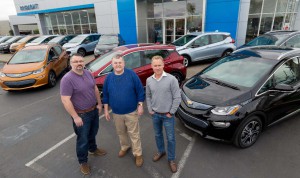
Customers Bobby Edmonds (l to r), William “Bill” Mattos and Steve Henry take delivery of the first three 2017 Chevrolet Bolt EVs Tuesday
The first three Chevrolet Bolt EVs have been delivered to retail customers in California, marking the start of sales of the market’s first long-range, relatively affordable battery-electric vehicles.
Industry experts believe that the Bolt could usher in a new era in which battery-cars finally start appealing to mainstream, rather than just green-minded, buyers by delivering range comparable to conventional, gas-powered vehicles without a hefty price premium. Chevy hits market as much as a year ahead of similar offerings coming from manufacturers including Tesla, Volkswagen and Nissan.
“The range and technology attracted me to the Bolt EV,” said Bobby Edmonds, a software developer from suburban San Francisco, who is replacing his BMW i3 with the Chevy Bolt. “It’s also a great-looking, roomy vehicle and I love the fact it’s from an American brand. I look forward to the longer drives I can make compared to the i3 that I owned.”
The other initial buyers include William Mattos, a retired police officer from Fremont, California, who previously owned both a Chevrolet Spark EV and a Chevy Volt plug-in hybrid. And Steve Henry, a commercial real estate broke from Portola Valley, California, replaced a Toyota Prius with his new Bolt.
The Bolt will originally be marketed in California which is the nation’s largest market for electrified vehicles, as well as one of a dozen states with strict new rules requiring automakers to sell zero-emissions vehicles. The Chevy hatchback will eventually go on sale across the rest of the country.
(Getting it right: Inside the Bolt plant. Click Here for the story.)
The General Motors division has not said how many Bolt EVs it expects to sale, but a senior official from LG Chem, the South Korean company producing the hatchback’s 60-kilowatt-hour lithium-ion battery pack, recently said the target is around 30,000 of the electric vehicles this year.
That’s a relatively modest number compared to the aspirations Tesla has for the upcoming Model 3. Since unveiling the car on March 31st, Tesla has already lined up more than 400,000 reservations for the similarly priced – albeit slightly lower-range – Model 3 it hopes to bring out about 8 to 12 months after Bolt.
At GM’s battery-car plant in Orion Township, Michigan, production of the Bolt is now running nearly 15 cars an hour on the line it shares with the conventional, gas-powered Chevrolet Sonic subcompact, or around 100 a day on a single eight-hour shift.
(Chevy Bolt named Green Car of the Year. Click Here to learn why.)
“And there’s more capacity at this plant if we need to tap into it,” says Yves Doutigny, the Bolt Launch manager, during a tour of the plant last week.
By some observers’ estimates, GM spent more than $1 billion to develop the Chevy Bolt EV. The figure could have been substantially higher – likely pricing the car out of the mainstream – if the maker hadn’t figured out how to produce Bolt on the same line as the conventional, gas-powered Chevrolet Sonic.
The good news for Chevy is that the Bolt EV is already receiving strong kudos. Among other things, it has been named both Motor Trend Car of the Year and Green Car of the Year. And it is one of three finalists for North American Car of the Year, that winner set to be announced on Jan. 9.
(Major automakers teaming up on super-fast EV charging project. Click Here for the story.)
“All of the hard work that the Chevrolet team have put into designing, engineering and building the Bolt EV brings us to this truly satisfying moment of making the first deliveries to customers on-time, as planned,” said Alan Batey, president of GM North America and Global Chevrolet brand chief.
